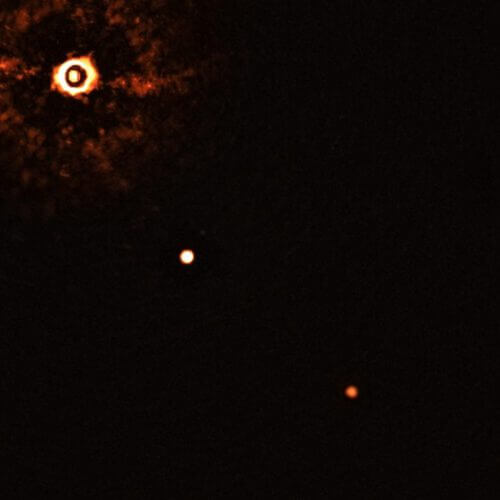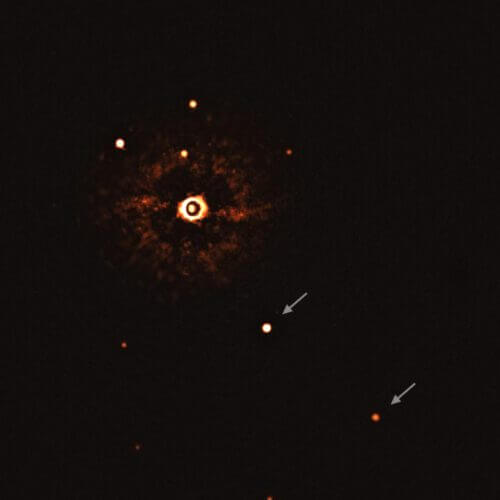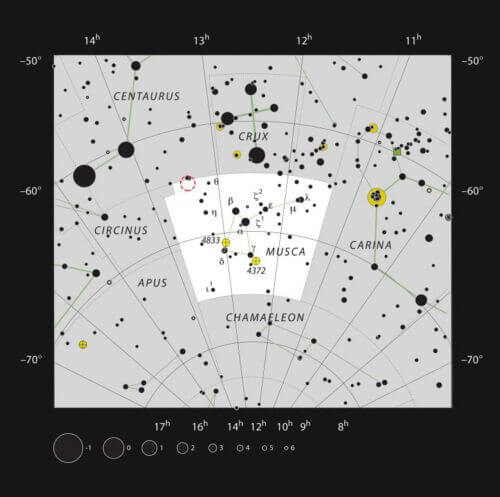The image was taken from the European Southern Observatory (ESO) in the Atacama Desert in Chile * This is the first time that astronomers have directly observed more than one planet orbiting a Sun-like star

The image was taken by blocking the light from the young Sun-like star (top left) using a coronagraph, which allows for the detection of fainter planets. The light and dark rings that you see on the image of the star are optical devices. The two planets are visible as two bright dots in the center of the image and in the lower right corner.
Credit: ESO/Bohn et al
The European Southern Observatory's (ESO) Very Large Telescope (VLT) has captured the first ever image of a young Sun-like star accompanied by two giant extrasolar planets. Images of systems with multiple extrasolar planets are very rare, and until now astronomers have never directly observed more than one planet orbiting a Sun-like star. The observations could help astronomers understand how planets formed and evolved around our sun.
The SPHERE instrument on ESO's Very Large Telescope captured the first ever image of a young Sun-like star accompanied by two giant extrasolar planets.
Just a few weeks ago, ESO discovered a nascent planetary system in a stunning new VLT image. Now the same telescope, using the same instrument, has taken the first direct image of a planetary system around a star similar to our Sun, located about 300 light-years away and called TYC 8998-760-1.
"This discovery is a snapshot of an environment that is very similar to our solar system, but at a much earlier stage of its development," says Alexander Boon, a doctoral student at Leiden University in the Netherlands, who led the new study published today (July 22, 2020) in The Astrophysical Journal Letters .
"Although astronomers have indirectly discovered thousands of planets in our galaxy, only a very small fraction of these solar exoplanets have been directly imaged," says co-author Matthew Kenworthy, associate professor at Leiden University, adding: "Direct observations are important in the search for environments that can support life." The direct imaging of two or more extrasolar planets around the same star is even rarer, only two such systems have been observed directly so far, both around stars very different from our Sun. ESO's new VLT image is the first direct image of more than one extrasolar planet around a Sun-like star. ESO's VLT was also the first telescope to directly photograph an extrasolar planet, in 2004, when it photographed a patch of light around a brown dwarf, a type of "failed" star.
The SPHERE instrument on ESO's Very Large Telescope has captured the first ever image of a young Sun-like star accompanied by two giant extrasolar planets, located about 300 light-years from Earth. This video takes us on a journey into this system.
"Our team has now managed to capture the first image of two companion gas giants orbiting a young solar analogue," says Madeleine Reggiani, a postdoctoral researcher at the Royal University of Louvain, Belgium, who also participated in the study. The two planets can be seen in the new image as two bright points of light at a distance from their parent star, which is in the upper left corner of the image (click on the image to see the entire image). By taking different images at different times, the team was able to differentiate between the planets and the background stars.

This image, taken by the SPHERE instrument on ESO's Very Large Telescope, shows the star TYC 8998-760-1 accompanied by two giant exoplanets, TYC 8998-760-1b and TYC 8998-760-1c. This is the first time that astronomers have directly observed more than one planet orbiting a Sun-like star.
Both planets are visible as two bright spots in the center of the image (TYC 8998-760-1b) and lower right (TYC 8998-760-1c), indicated by arrows. Other bright spots, which are background stars, are also visible in the image. By taking different images at different times, the team was able to differentiate between the planets and the background stars.
The image was taken by blocking the light from the young Sun-like star (top left of center) using a coronagraph, which allows the detection of fainter planets. The light and dark rings that you see on the image of the star are optical devices.
Credit: ESO/Bohn et al
The two gas giants orbit their host star at distances of 160 times and about 320 times the distance between Earth and the Sun. This means that these two planets are much further from their star than Jupiter or Saturn, also two gas giants, far from the Sun: they are only 5 and 10 times the distance between Earth and the Sun, respectively. The team also found that the two exoplanets are much heavier than those in our solar system, the inner one having 14 times the mass of Jupiter and the outer one 6 times the mass.
Boon's team photographed this system while searching for young giant planets around stars similar to our Sun but much younger. The star TYC 8998-760-1 is only 17 million years old and is located in the southern constellation Musca (the Fly). Boon describes it as "a very young version of our Sun".
The SPHERE instrument on ESO's Very Large Telescope has captured the first ever image of a young Sun-like star accompanied by two giant extrasolar planets, located about 300 light-years from Earth. This animation shows the orbits of the two exoplanets compared to the size of Pluto's orbit. (Note that the yellow circle does not represent the actual orbit of Pluto, but the size of the orbit, which is calculated based on the average distance of the dwarf planet from the Sun).
These images were made possible by the powerful performance of the SPHERE instrument at ESO's VLT in Chile's Atacama Desert. SPHERE blocks the bright light from the star using a device called a coronagraph, which allows the much fainter planets to be seen. Older planets, such as those in our solar system, are too cold to be found using this technique, but younger stars are hotter and therefore glow brighter in infrared light. By taking several images over the past year, and also using older data up to 2017, the research team confirmed that the two planets are part of a star system.
Further observations of this system, including by ESO's future Extremely Large Telescope (ELT), will allow astronomers to test whether these planets formed at their current distance from the star or moved from elsewhere. ESO's ELT will also help study the interaction between the two young planets in the same system. Boon concludes: "The possibility that future instruments, such as those available on the ELT, will be able to discover planets with even smaller masses around this star is a landmark in the understanding of multi-planet systems, with potential implications for the history of our solar system."

More of the topic in Hayadan:

6 תגובות
I assume that the team of researchers who published the image and the accompanying article also took into account the possibilities raised here by some amateur astronomers who want to voice their knowledge on the subject. So friends, how do you say?
"A little modesty"? Researchers and astronomers from these leagues who researched discovered and published the photograph will not fall into this net. They went back and checked all the options before posting. And if they answer what they claim, it is from a very deep knowledge of the subject. Again, "a little modesty"
It's like going to the garage and you don't understand anything about the car and they tell you that they found the fault, go and believe them it's expensive and in fact there is no fault at all and there are no stars around the sun
Nachshon Yeshuron
The planets appear as circles due to the telescope's limited resolution.
When you want to see planets, you hide the sun so as not to dazzle the sensor in the telescope.
This picture immediately raises 2 questions
A. Planets are not supposed to have their own light. If you see them it is only as a result of the reflection of light from their sun. However, in order to return light to the direction of the earth in the form of a full circle, they must find a turtle opposite to their sun in relation to the earth. And that is certainly not the case. Therefore it does not seem that the bright objects appearing in the image are indeed planets. It seems more wishful thinking of the researchers
B. What is the black spot that appears in the middle of the star that is supposed to be the distant sun????
Yehuda
I don't think we see the planets themselves - their angular size is much smaller than the telescope's resolution. Therefore it is clear that shows cannot be seen.
Estimating the radius is a complex process, because the information is not a simple optical photograph. The photography process is very complex and there are methods (that I haven't understood yet) for calculating the radius.
Here is a link to an article that explains the process - https://academic.oup.com/mnras/article/492/1/431/5680498
I don't want to take the fun out of the very, very big success of the very, very large telescope, but...
Doesn't the size of these planets show that they are actually brown dwarfs (at least the larger of the two)? And so it's easier to photograph them? In that case, maybe they should be treated as a three-star system like our neighbors Alpha Centauri?
Maybe that's why you don't see the planets illuminated only in part like Venus or our moon?
In any case, even if I'm wrong, then please respond gently.
Thanks
Yehuda